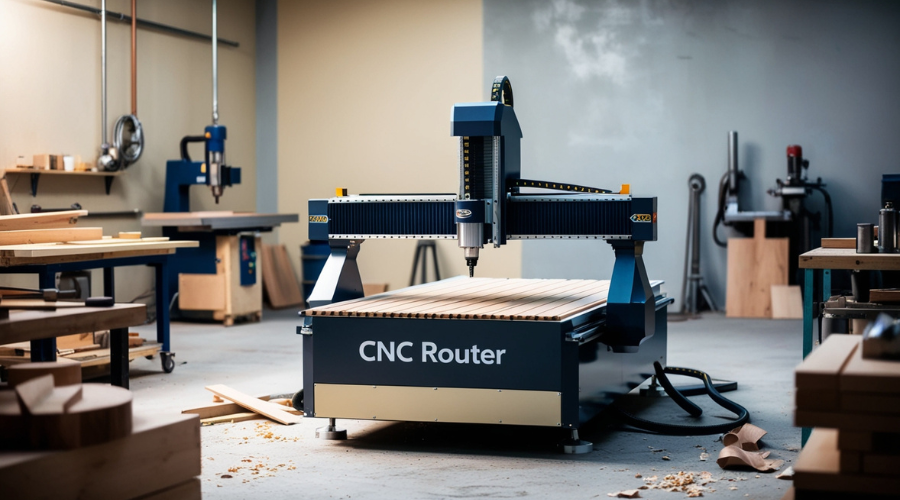.jpg)
Blogs
Understanding CNC Routers: A Beginner's Guide

People who listen to others talk about CNC routers often get confused about what they are. A simple understanding of CNC routers shows they have developed into intriguing devices.
This blog explains CNC routers, including their functionality and applications, and details their widespread adoption across industries and individual usages. We will simplify the explanation of CNC routers and how they work to help beginners understand them.
What Is a CNC Router?
A CNC router is a brilliant machine designed for cutting operations. It operates under Computer Numerical Control since a computer system manages the machine's movement patterns and cutting capabilities. With the help of software instructions, this gadget operates like an automated carpenter.
A CNC router uses bits to cut various materials, including soft metals, plastic, and wood. This intelligent machine shapes materials through cutting movements akin to pencil drawings.
How Does a CNC Router Function?
The process consists of three easy stages.
- • Design: In the first step, you design your project using CAD software on a computer system, which stands for Computer-Aided Design. You develop an electronic design representation that functions as a digital blueprint.
- • Convert: After creating the design, you must transform it into a set of programming instructions, which the CNC router understands as G-code. The machine receives instructions that indicate its location points and cutting timing.
- • Setup: You set up the CNC router process by placing your material onto the table and securing it for static operation during the cutting phase.
- • Run: After receiving your instructions, the CNC router moves its cutting tool according to your design.
- • Finish: You will find your completed workpiece when the machine completes its operation.
Parts of a CNC Router
A CNC router contains multiple essential elements that include:
- • Frame: The machine body functions as its primary structural component, maintaining all components properly. Its structural integrity must be high to avoid machine vibrations when performing cuts.
- • Bed: The flat surface, known as the bed, receives the material placed on it. The material stays secure on the bed because it contains clamps or vacuum systems for holding purposes.
- • Spindle: The spindle unit maintains and rotates the operational cutting device like a mighty drill.
- • Motors: These move the spindle around in different directions. Most CNC routers move in three directions: left-right motion (X-axis), front-back movement (Y-axis), and vertical movement (Z-axis).
- • Controller: The machine's central processing unit interprets computer commands to direct motor operations.
Types of CNC Routers
Different CNC router models exist in numerous dimensions:
- • Hobby/Desktop CNC Routers: Hobby/Desktop CNC Routers are minor machine versions that operate from desktop surfaces. Their compact design suits novice users who create small wooden products such as signs, decorative pieces, and models. Small projects involving softer materials cost less, but the machines cannot handle large or dense cutting operations.
- • Mid-size CNC routers: Mid-size CNC routers provide large-scale capabilities with high power and serve businesses that operate at a small scale or are intense hobbyists. The machines operate on bigger tasks while handling dense materials.
- • Industrial CNC Routers: Industrial CNC Routers are large, heavy-duty equipment in industrial workplaces and big workshop environments. These machines operate endlessly yet require extensive funding and production facilities.
Benefits of CNC routers
You can make almost anything with a CNC router, but here are some common ones:
- • Toys and game pieces
- • Parts for larger projects
- • Custom decorations
- • Signs and lettering
- • Furniture parts
- • Cabinet doors
- • Guitar bodies
- • 3D carvings and artwork
- • Custom plaques
Materials Selection
The CNC router technology accepts numerous material types for processing. Your learning experience will clarify each material's required cutting speeds and tool types.
- • Wood: The CNC router operates on wood varieties from plywood to MDF alongside hardwoods and softwoods.
- • Plastics: Other types of plastics include acrylic, PVC, and HDPE.
- • Soft metals: The machine needs high power for aluminum, brass, and copper; steel and iron are off-limits.
- • Foam: Foam becomes appropriate for signboards, decorative props, and packaging applications.
- • Composites: Materials like carbon fiber or fiberglass.
Getting Started with CNC Routing
The process to start CNC routing consists of several steps.
1. Learn the Software
Learning CAD software must be your first step before operating any machine. Free options include:
- • Fusion 360 (free for hobbyists)
- • FreeCAD
- • SketchUp Free
You will need CAM software (Computer-Aided Manufacturing) to convert your designs into machine instructions. The majority of CAD software applications include integrated CAM functionality.
2. Choose Your First Machine
For beginners, consider:
- • A desktop CNC router kit
- • A used entry-level machine
- • Joining a local maker space will provide access to their CNC router equipment
Purchasing your initial machine should not be an impulse purchase of the cheapest option available.
3. Start with Simple Projects
The learning process should start with basic flat designs preceding attempts at advanced 3D carvings. Good starter projects include:
- • Simple signs
- • Coasters
- • Basic brackets or joins
- • Nameplates
- • Simple decorative items
4. Safety First
Safety is still paramount during CNC router operations, even if the machines offer better surroundings than usual workshop equipment but still call for correct safety procedures.
- • Always wear safety glasses.
- • Wear protective ear devices because CNC routers generate substantial noise levels.
- • You should tie your long hair back while avoiding loose-fitting clothing.
- • Avoid reaching into the machine when it operates.
- • Dust collection systems should be used whenever possible because cutting operations generate excessive dust.
Standard Terms You Will Hear
The following terms will likely create confusion for beginners who learn about CNC routers:
- • Bit: The spinning tool called Bit functions as the material removal component.
- • Feeds and Speeds: The machine operates at a specified feed rate speed while the cutting tool rotates at a particular speed due to feeds and speeds.
- • Toolpath: Your cutting tool will trace a specific path known as a toolpath.
- • Pockets: Pockets represent the operational areas that do not penetrate material fully.
- • Profile Cuts: The material receives complete cuts from Profile Cuts.
- • Tabs: You need tabs that function as small, unmodified sections that maintain your workpiece position during cutting.
- • Depth Per Pass: A cutting operation should only reach this specified depth before the tool makes another cycle.
- • Stepover: When removing material from an area, the bit overlaps with past cuts, an amount referred to as stepover.
Common Mistakes to Avoid
The beginning stage of learning involves making errors by everyone. Here are some common ones:
- • Rushing during cutting operations leads to broken bits and rough surface quality.
- • Multiple shallow cuts are more effective than performing one deep slice.
- • The improper fixation of material will cause your project to fail because the material shifts during cutting.
- • Selecting inappropriate bits for different materials and different cuts is a mistake.
- • The diameter of your bit creates a circular radius because the bit has thickness when you cut inside corners.
- • The dust produced during CNC routing requires sufficient dust management planning.
Tips for Success
- • Online tutorials provide numerous free educational videos about CNC techniques.
- • Many helpful CNC enthusiasts exist in both forums and Facebook groups online.
- • Write down successful and unsuccessful techniques in a project notebook for future reference.
- • Use inexpensive wood as your first material when learning CNC operations.
- • Follow the manual instructions to maintain your machine by cleaning it and applying lubrication.
- • Learning CNC routing requires patience since practice makes it easier to master.
Is CNC Routing Right for You?
The CNC routing system suits your needs if you meet these three criteria.
- • Your interests include computer work as well as physical craftsmanship skills
- • You prefer manufacturing things that need accuracy and repetition in their outcomes.
- • You possess sufficient area for the equipment and dust collection systems.
- • You have both the ability to wait patiently and you enjoy learning new abilities.
It might not be ideal if:
- • Do you prefer purely hand-crafted work
- • You're looking for instant results
- • You have minimal space
- • You're uncomfortable with computer design
Final Thoughts
The CNC routing system enables technical makers to create practically any shape. The initial difficulty of learning brings rewarding outcomes for CNC users. Your CNC router will generate precise and sophisticated items that cannot be duplicated manually.
All experienced CNC operators learned their skills from the beginner stages. The foundation of learning CNC starts with a dedication to gradual progression and embracing every mistake because this method helps us understand new things. After gaining enough experience, you will begin designing and creating exceptional projects using your CNC router.
